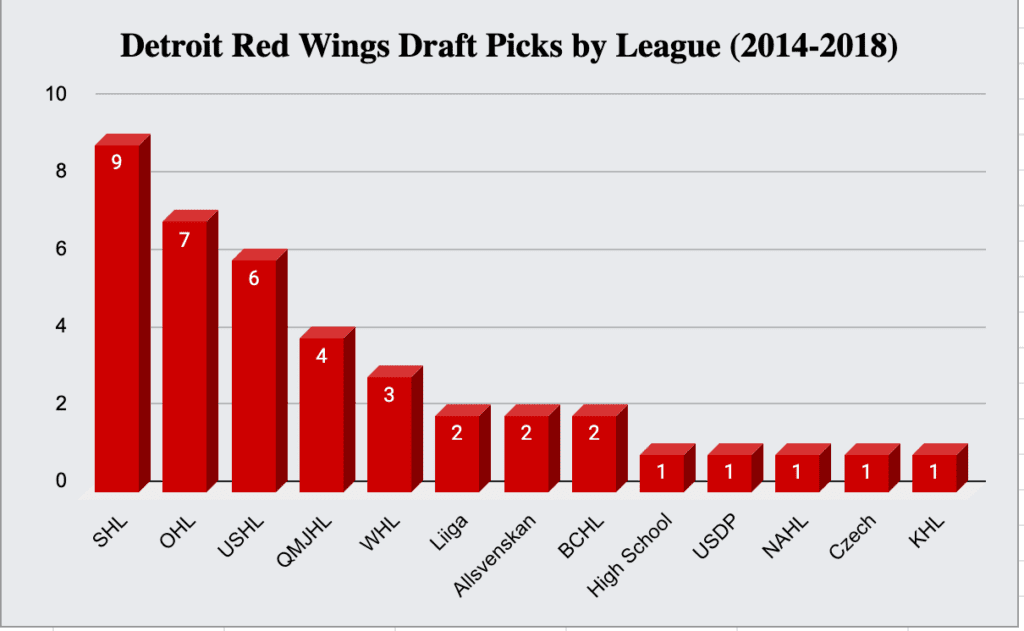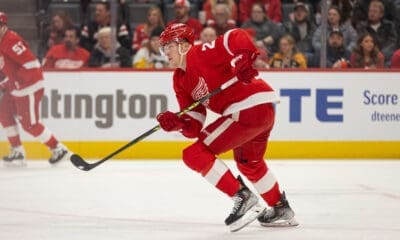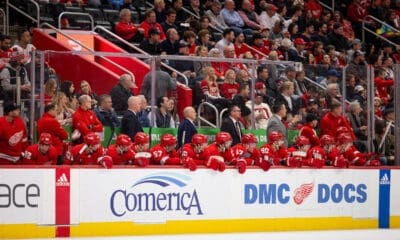Detroit Red Wings
Anatomy of the Yzerplan: Holland vs Yzerman Red Wings’ Drafts

The first two pieces of Analyzing the Yzerplan looked at how the Detroit Red Wings drafted through every round by position and the league they were taken from.
Now it’s time to investigate things pre-Yzerman, specifically, did the Red Wings radically deviate from what former general manager Ken Holland was doing? Was it comparable?
After all, the Red Wings were scouting overseas even before Holland was running the show.
For the purposes of this piece and brevity, I’m choosing to start with the 2014 draft. This piece will examine Detroit’s choices from 2014-2018, and break it down similarly to the previous pieces.
Then, we’ll draw compare the similarities and differences.
Red Wings Were in a Different Place in 2014
The Red Wings 2014 playoff exit was the first where many experts wondered if better days were behind the organization. Going out of the first round with a whimper against Boston in five games, Holland still viewed Detroit as a few pieces from going deeper in the playoffs. 2015 did in fact see the Red Wings go further, but just by three games. They fell to Tampa in seven games, and then again in 2016 in five. From there, they wouldn’t see the playoffs again.
So it seems fair to start the analysis with the final four years of Holland’s tenure. The “rebuild” truly didn’t start until 2017, but in a cap league, even Holland realized he had to start looking ahead as much as he wanted to believe the team could still compete.
His 2013 draft was quite fruitful, garnering Anthony Mantha, Tyler Bertuzzi, and Mattias Janmark. But the year after would be where draft deficiencies hurt Detroit’s hopes of rebuilding on the fly.
Holland’s Red Wings Drafts By Round

Holland’s first round choices have been so scrutinized, there isn’t much reason to rehash it. Four of his six first round picks during that time are now at the NHL level. Outside of Larkin, however, the picks are missing the foundational factor of Moritz Seider and Lucas Raymond.

The second round was perhaps Holland’s best work. The first three (Smith, Hronek and Lindstrom) are all on the roster while the latter two saw major ice time in 2021-22. Hronek is a second pairing defenseman as well. Berggren was considered a steal at the time, and his season with Grand Rapids this past season all but pencils him into the opening night roster in Detroit. McIssac has fought through injuries, but has been solid in his first full season in 2021-22.

For as good as the second round was, the Red Wings failed to produce with their third round picks. Of the eight picks in the round, only Barton remains in the system. The rest were either not tendered, or traded away (Saarijarvi, Regula). Interestingly, not one player was taken from a league overseas.

Ehn saw time in the NHL, but opted to go back to Sweden following the 2018-19 season. O’Reilly and Van Pottelberghe remain in the system. Nearly the opposite of the third round, 80% of the picks were from the SHL junior teams.

The fifth round featured the least amount of picks and outside of Pearson, none of those draftees remain with the team.

The sixth round was a 50-50 split of international and domestic picks. Of the choices, only Brattstrom and Adams are still with the organization.

Finally, the seventh round saw the bulk of picks taken from overseas. As it often goes in the seventh round, there weren’t any hits. Holmstrom looked promising, but it didn’t pan out. Kadeykin’s rights are still held by the Red Wings but he’s currently playing in Russia.
Breakdown by Position and League
For this portion, the positional breakdown is placed against one another by general manager. Of note, Holland’s sample size includes one additional season (5) to Yzerman’s four. Both general managers had 40 selections each. Below it how it breaks down:

It’s interesting that both Holland and Yzerman chose defensemen more than any other position. The difference, however, is that Yzerman prioritized his defenseman higher with first round picks going to both Seider and Simon Edvinsson, both out of professional leagues. Of the 14 defenseman Holland selected, Cholowski was the highest pick at 20th, and he’s no longer with the organization. Both Lindstrom and Hronek have been productive at the NHL level. Beyond that, McIsaac and Barton are in the system.
Holland never picked a goalie higher than the third round, and only Brattstrom seems to have a chance to actually see NHL time, though it’s likely in a backup role. Holland’s work in the first few rounds saw some success (Larkin, Rasmussen, Zadina, Veleno, Smith and Berggren), but it thins out dramatically from there. Pearson has a chance while Ehn couldn’t stick in the league.
Looking at the numbers, much of late round magic that defined Holland previously wasn’t as evident.
Red Wings Selections by League

The SHL was a popular choice for the Red Wings from 2014-2018, but it was taking players in the junior ranks rather than the big club as Yzerman has done with Edvinsson and recent pick Marco Kasper. From there, it’s a big difference. Of the 40 picks Holland made, 14 came from the CHL, with half being from the OHL. Breaking it down further, half of the picks came from the CHL and USHL.
When looking at selections side-by-side, 11 of the 80 picks were from different leagues. Yzerman went heavier in the SHL, especially early on while picking less in the OHL and QMJHL. He also out selected Holland in the USHL.

Final Thoughts
Looking at the entire body of work for both general managers, many of the observations made over the past few years regarding the drafting differences have been backed up statistically. Yzerman has gone heavier in the international leagues while Holland tended to favor the Canadian junior leagues, with 35% of his picks coming from north of the border. The strategy for Detroit paid off in earlier rounds, but the magic wasn’t there as the rounds went later.
A final takeaway here is that Holland and Yzerman had different objectives when drafting. Holland had playoff teams until 2017, using draft capital to acquire talent for long playoff runs. It didn’t pay off, and when push came to shove, Holland started targeting the acquisition of picks instead of peddling.
During Yzerman’s tenure, he’s simply looked to acquire as many picks as he could while rarely, if ever, surrendering them. Though there’s a different mindset, Yzerman has done well with his first round picks, making sure those foundational pieces are being set. The later rounds will come into focus over the next few years.
In some ways it’s comparing apples and oranges as expectations shifted. Some of the Red Wings woes were from acquisitions via free agency and trades. But Yzerman’s strategy, at least just looking at the earliest of returns, seems to be yielding more in the way of value.
Ironically, Holland’s best work seems to have occurred in his final draft, setting Yzerman up nicely to continue the forward momentum.















